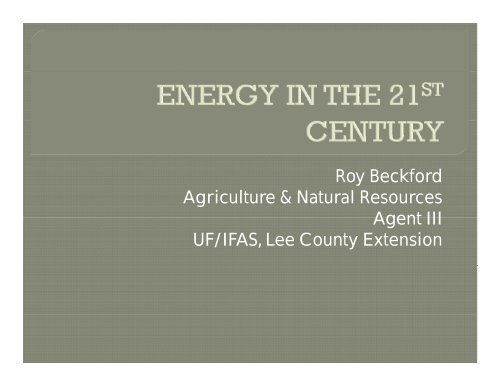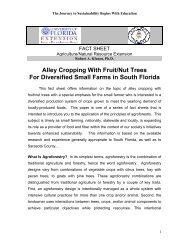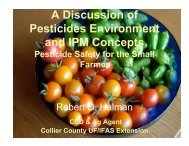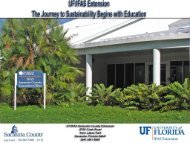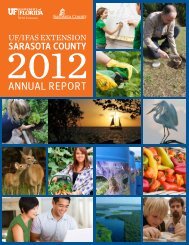Energy in the 21st Century - Sarasota County Extension
Energy in the 21st Century - Sarasota County Extension
Energy in the 21st Century - Sarasota County Extension
Create successful ePaper yourself
Turn your PDF publications into a flip-book with our unique Google optimized e-Paper software.
Roy Beckford<br />
Agriculture & Natural Resources<br />
Agent III<br />
UF/IFAS, Lee <strong>County</strong> <strong>Extension</strong>
Coal<br />
Petroleum<br />
Natural Gas<br />
The Carboniferous Period – 350 Mil yrs. ago<br />
http://www.globalfundexchange.com/resources/sectorfocus/traditional-energy
S<strong>in</strong>ce <strong>the</strong> Industrial Revolution,<br />
humans have greatly <strong>in</strong>creased <strong>the</strong><br />
quantity of carbon dioxide <strong>in</strong> <strong>the</strong><br />
atmosphere and oceans.<br />
Atmospheric levels have <strong>in</strong>creased<br />
by over 30%, from about 275 parts<br />
per million (ppm) <strong>in</strong> <strong>the</strong> early 1700s<br />
to over 390 PPM today.<br />
Scientists estimate that future<br />
atmospheric levels of carbon dioxide<br />
could reach an amount between 450<br />
to 600 PPM by <strong>the</strong> year 2100.<br />
The major sources of this gas due to<br />
human activities <strong>in</strong>clude fossil fuel<br />
combustion and <strong>the</strong> modification of<br />
natural plant cover found <strong>in</strong><br />
grassland, woodland, wetland and<br />
forested ecosystems.
Carbon is stored on Earth <strong>in</strong> <strong>the</strong><br />
follow<strong>in</strong>g major s<strong>in</strong>ks<br />
(1)as organic molecules l <strong>in</strong> liv<strong>in</strong>g<br />
i<br />
and dead organisms found <strong>in</strong> <strong>the</strong><br />
biosphere. Anyth<strong>in</strong>g with carbon<br />
molecules is an organic molecule<br />
(2)as <strong>the</strong> gas carbon dioxide id <strong>in</strong><br />
<strong>the</strong> atmosphere<br />
(3)as organic matter <strong>in</strong> soils<br />
(4)<strong>in</strong> <strong>the</strong> lithosphere as fossil fuels<br />
and sedimentary rock deposits<br />
such as limestone, dolomite and<br />
chalk<br />
(5)<strong>in</strong> <strong>the</strong> oceans as dissolved<br />
atmospheric carbon dioxide ide<br />
and as calcium carbonate shells<br />
<strong>in</strong> mar<strong>in</strong>e organisms.
The carbon cycle is <strong>the</strong> set of biogeochemical processes<br />
(such as Photosyn<strong>the</strong>sis th and Respiration) by which<br />
h<br />
carbon undergoes chemical reactions, changes form,<br />
and moves through different reservoirs on earth,<br />
<strong>in</strong>clud<strong>in</strong>g liv<strong>in</strong>g i organisms such as plants and animals<br />
Photosyn<strong>the</strong>sis: th energy (sunlight) + 6CO2 + H2O C6H12O6 + 6O2<br />
Respiration: i C6H12O6 (organic matter) + 6O2 6CO2 + 6 H2O + energy
Carbon is <strong>the</strong> ma<strong>in</strong><br />
component of biological<br />
compounds;<br />
The term ‘organic’<br />
synonymously means<br />
‘conta<strong>in</strong><strong>in</strong>g carbon’<br />
Comb<strong>in</strong>ed with o<strong>the</strong>r<br />
elements, carbon is a major<br />
component of many m<strong>in</strong>erals<br />
The carbon cycle susta<strong>in</strong>s<br />
basic life patterns on Earth
Fossil fuel combustion rema<strong>in</strong>s <strong>the</strong> largest contributor<br />
to <strong>in</strong>creased CO2 releases <strong>in</strong>to <strong>the</strong> atmosphere<br />
Forest clear<strong>in</strong>g reduces <strong>the</strong> ability of photosyn<strong>the</strong>sis to<br />
remove CO2 from <strong>the</strong> atmosphere, also result<strong>in</strong>g <strong>in</strong> a<br />
net <strong>in</strong>crease<br />
CO2 <strong>in</strong>creases <strong>the</strong> atmosphere’s ability to hold heat<br />
Global temperature will <strong>in</strong>crease between 1.4 and 5.8<br />
degrees C over <strong>the</strong> next century as a result of <strong>in</strong>creases<br />
<strong>in</strong> atmospheric CO2
The Keel<strong>in</strong>g Curve (above right) has been hailed as <strong>the</strong> most<br />
rigorous and fundamental measure of global change<br />
Source: http://www.ipcc.ch/publications_and_data/ar4/wg1/en/ch7s7-3-1-<br />
2.html
(Alternative) Renewable <strong>Energy</strong> Sources<br />
Hydrogen<br />
Solar<br />
<strong>Energy</strong><br />
Tidal<br />
W<strong>in</strong>d<br />
<strong>Energy</strong><br />
Alternative<br />
Renewable<br />
<strong>Energy</strong><br />
Geo<strong>the</strong>rmal<br />
Biomass<br />
Hydropower<br />
10
With 90 500 l l t 42 000 tt h<br />
With 90,500 solar panels, generates 42,000 megawatt-hours<br />
or enough power to serve about 3,000 homes
Lee <strong>County</strong> Waste to <strong>Energy</strong> Facility<br />
The facility processes 1,836 tons-per-day of solid waste while<br />
generat<strong>in</strong>g up to 57.3 megawatts of clean, renewable energy with<br />
approximately 50 megawatts sold to Sem<strong>in</strong>ole Electric Cooperative.
Mar<strong>in</strong>e Turb<strong>in</strong>es
Bio-ref<strong>in</strong>eries – Vegetable oil<br />
Bio-production - Ethanol
“The use of Vegetable<br />
oils (Bio Diesel) for<br />
eng<strong>in</strong>es may seem<br />
<strong>in</strong>significant today. But<br />
such oils may become<br />
<strong>in</strong> course of time as<br />
important as<br />
Petroleum and Coal<br />
tar products of <strong>the</strong><br />
present time" - Rudolf<br />
Diesel, 1912
Biomass and Biofuels<br />
UF/IFAS Lee <strong>County</strong> Focus<br />
• Camel<strong>in</strong>a (Oil)<br />
• Kenaf (Biomass)<br />
• Jatropha (Oil)
Camel<strong>in</strong>a sativa<br />
• A member of <strong>the</strong> mustard family, is<br />
a summer annual oilseed plant.<br />
• Intercrops well with Jatropha curcas<br />
• Adapted d to cool arid climates<br />
• Camel<strong>in</strong>a has nearly 40% omega-3<br />
• Produces soy meal quality meal<br />
and canola quality oil<br />
• Meal can be used for special high<br />
omega feed for fish, poultry, beef<br />
and dairy cattle, hogs, goats and<br />
pets
Hibiscus canabanus (Kenaf)<br />
• Four cultivars…fiber used as biomass
Kenaf and Carbon Sequestration<br />
• One acre of Kenaf yields 10 tons of<br />
Fiber<br />
• One acre of Kenaf sequesters almost<br />
10 tons of carbon from <strong>the</strong> air<br />
• Researcher Bill Loftus patented a<br />
build<strong>in</strong>g block from kenaf (9 lbs)<br />
• Block is super <strong>in</strong>sulat<strong>in</strong>g and fireproof<br />
(mixed with concrete)<br />
• Pilot projects underway <strong>in</strong> Haiti and<br />
South Africa
Grows well <strong>in</strong> tropics<br />
Frost <strong>in</strong>tolerant<br />
Wild varieties <strong>in</strong>vasive<br />
<strong>in</strong> Florida
Large fruit/seed varieties <strong>in</strong> Paraguay
Oldest technology on<br />
<strong>the</strong> Earth<br />
Practiced by <strong>in</strong>digenous<br />
people worldwide<br />
Pulverized charcoal<br />
identified d as a soil<br />
amendment by south<br />
American Indians<br />
Referred to as ‘black<br />
gold’ by Portuguese<br />
explorers
Biochar is produced us<strong>in</strong>g pyrolysis, that is,<br />
biomass is super-heated <strong>in</strong> <strong>the</strong> absence of<br />
oxygen at high temperatures (350-700° C) <strong>in</strong><br />
specially designed furnaces.<br />
The most susta<strong>in</strong>able feed stocks are what<br />
are now considered waste: excess manure,<br />
wood debris, construction waste, slash from<br />
forest th<strong>in</strong>n<strong>in</strong>g (or land clear<strong>in</strong>g), food<br />
process<strong>in</strong>g waste, residue from methane<br />
digesters or urban tree trimm<strong>in</strong>gs.
In this modern method, volatile gasses,<br />
hydrocarbons and most of <strong>the</strong> oxygen and<br />
hydrogen <strong>in</strong> <strong>the</strong> biomass are burned or driven<br />
off and captured, <strong>in</strong>clud<strong>in</strong>g greenhouse gases<br />
(GHG's).<br />
These captured emissions are known as syngas<br />
(syn<strong>the</strong>tic gas) and can be used like natural a gas.<br />
Liquids, called bio-oils, are also captured<br />
creat<strong>in</strong>g ano<strong>the</strong>r source of energy, leav<strong>in</strong>g<br />
carbon enriched biochar.<br />
The heat generated dur<strong>in</strong>g <strong>the</strong> pyrolysis process<br />
can also generate electricity.
DEFORESTATION<br />
AFFORESTATION<br />
<br />
<br />
<br />
<br />
Tropical deforestation is<br />
responsible for approximately<br />
20% of world greenhouse gas<br />
emissions.<br />
The water cycle is negatively<br />
affected by deforestation<br />
Shr<strong>in</strong>k<strong>in</strong>g forest cover lessens<br />
<strong>the</strong> landscape's capacity to<br />
<strong>in</strong>tercept, reta<strong>in</strong> and transpire<br />
precipitation<br />
Damage to forests and o<strong>the</strong>r<br />
aspects of nature could halve<br />
liv<strong>in</strong>g standards for <strong>the</strong> world's<br />
poor and reduce global GDP by<br />
about 7% by 2050<br />
<br />
<br />
<br />
<br />
Tropical afforestation will<br />
<strong>in</strong>creas<strong>in</strong>gly gysequester and<br />
capture carbon dioxide.<br />
The water cycle benefits from<br />
afforestation<br />
Expand<strong>in</strong>g forest cover<br />
<strong>in</strong>creases <strong>the</strong> landscape’s<br />
capacity to <strong>in</strong>tercept, reta<strong>in</strong> and<br />
transpire precipitation<br />
Investments <strong>in</strong> afforestation and<br />
o<strong>the</strong>r aspects of nature will<br />
stabilize <strong>the</strong>n improve liv<strong>in</strong>g<br />
standards for <strong>the</strong> world’s poor<br />
and <strong>in</strong>crease global GDP by 7%<br />
by 2050
Scientists have<br />
estimated that if<br />
applied on a global<br />
scale, such 'bioenergy<br />
with carbon<br />
storage' (BECS)<br />
systems can br<strong>in</strong>g<br />
atmospheric CO2<br />
levels back to pre<strong>in</strong>dustrial<br />
levels by<br />
mid-century (2050).
BECS is a biomass<br />
technology or<br />
approach that removes<br />
CO2 from <strong>the</strong><br />
atmosphere and at <strong>the</strong><br />
same time deliver CO2<br />
neutral energy carriers<br />
such as heat, electricity<br />
it<br />
or hydrogen to society
Recognize that ongo<strong>in</strong>g g changes <strong>in</strong> climate<br />
and environment conditions raise new<br />
challenges to agriculture, fish<strong>in</strong>g and<br />
forestry<br />
Elaborate on <strong>the</strong>oretical messages and<br />
practical measures for susta<strong>in</strong>able<br />
development of agriculture and forestry<br />
under chang<strong>in</strong>g climate and environment<br />
Establish partnership between ‘government’<br />
and ‘nongovernment’ to build new<br />
foundations for environmental law, policy,<br />
education and <strong>in</strong>dividual <strong>in</strong>centives for<br />
address<strong>in</strong>g change.<br />
Source: http://puspitadewi.com/blog/


